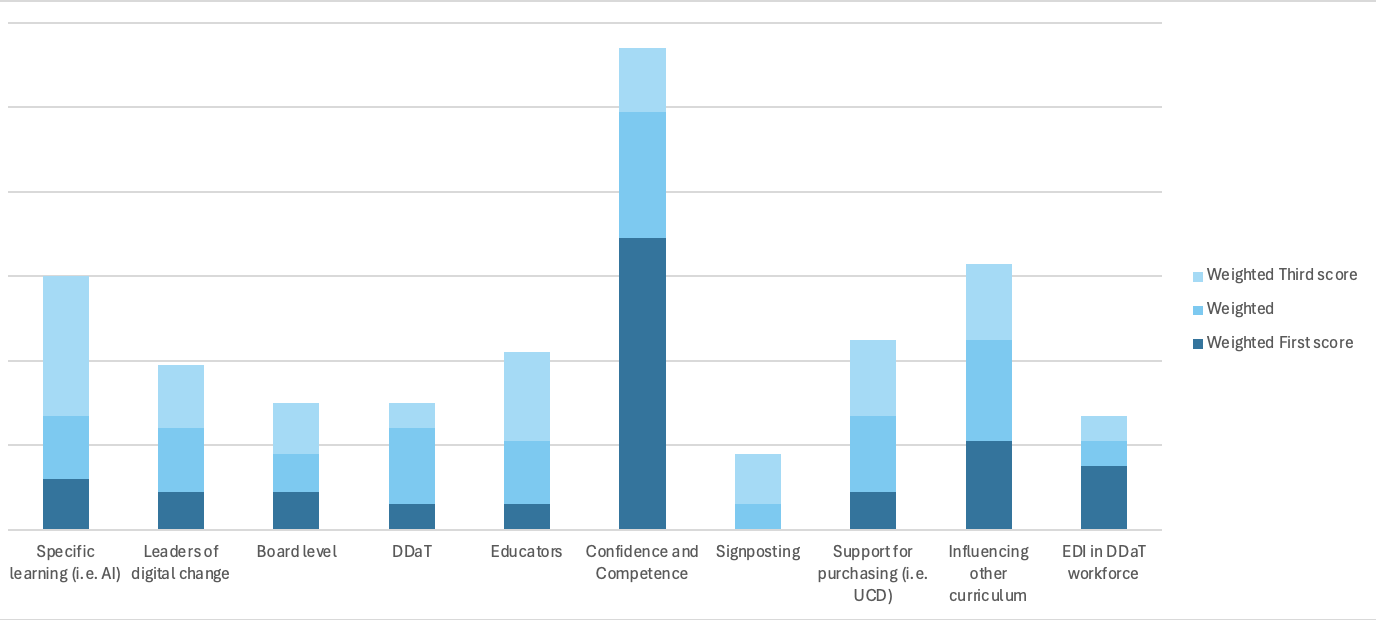Understanding our Prioritisation Survey: insights and analysis
We recently reviewed the work we are hoping to undertake in the next financial year and we prioritised this as a team.
We were challenged to see if our priorities matched those of our stakeholders, and decided to create a short survey to send to stakeholders which would ask for their opinion.
The survey process
The Prioritisation Survey was designed to capture both qualitative and quantitative data from our stakeholders. Participants were asked to rank various initiatives based on their perceived importance and urgency. The survey included a mix of open-ended questions and rating scales to ensure a comprehensive understanding of stakeholder priorities.
Key findings
The analysis of the survey data revealed several critical insights. The Digital and Data Confidence and Competence (DDCC) emerged as the highest priority, receiving the most first-place rankings. This indicates a strong demand for initiatives that enhance digital literacy and data competence among our stakeholders. Influencing other curriculums, such as clinical education, was identified as the second-highest priority, slightly edging out specific learning areas like Artificial Intelligence (AI).
Quantitative analysis
To quantify the survey responses, we assigned weighted scores to the rankings: three points for a first-place ranking, two points for a second-place ranking, and one point for a third-place ranking. This approach allowed us to objectively measure the relative importance of each initiative. The weighted scores confirmed that DDCC is the top priority, followed by influencing other curriculums and specific learning areas.
Qualitative insights
In addition to the quantitative data, the survey also provided rich qualitative insights. Stakeholders shared their thoughts on the importance of digital literacy and the need for comprehensive training programs. Many respondents emphasised the necessity of integrating digital skills into existing curriculums to ensure that all staff members are equipped to navigate the digital landscape effectively.
Implications for our strategy
The findings from the prioritisation survey have significant implications for our strategic planning. The clear prioritisation of DDCC highlights the need to invest time and effort into initiatives that build digital and data competence across our organisation.
Furthermore, the emphasis on influencing other curriculums underscores the importance of collaboration with clinical training programmes and professional bodies. By integrating digital skills into clinical and other professional education programs, we can ensure that our workforce is prepared for the evolving demands of the healthcare sector.
Next steps
Based on the survey results, we will be taking several key actions. First, we are currently undertaking user research to investigate exactly what interventions will have the biggest impact to confidence and competence within digital and data and will report back later in the year on the results of that research. We will also work closely with educational partners to look at ways we can integrate digital skills into their curriculums, ensuring a holistic approach to digital literacy.
Additionally, we will continue to engage with our stakeholders to gather feedback and refine our initiatives. The prioritisation survey is just one step in our ongoing effort to align our strategies with the needs of our wider healthcare community. By maintaining an open dialogue and actively seeking input, we can ensure that our initiatives remain relevant and impactful.
Conclusion
The prioritisation survey has provided us with valuable insights that will shape our strategic direction. By focusing on confidence and competence and influencing other curriculums, alongside specific training for subjects such as Artificial Intelligence, we can enhance the digital competence of our workforce and better prepare for the future. We are committed to leveraging these insights to drive meaningful change and support the ongoing development of our organisation.

Page last reviewed: 16 January 2025
Next review due: 16 January 2027